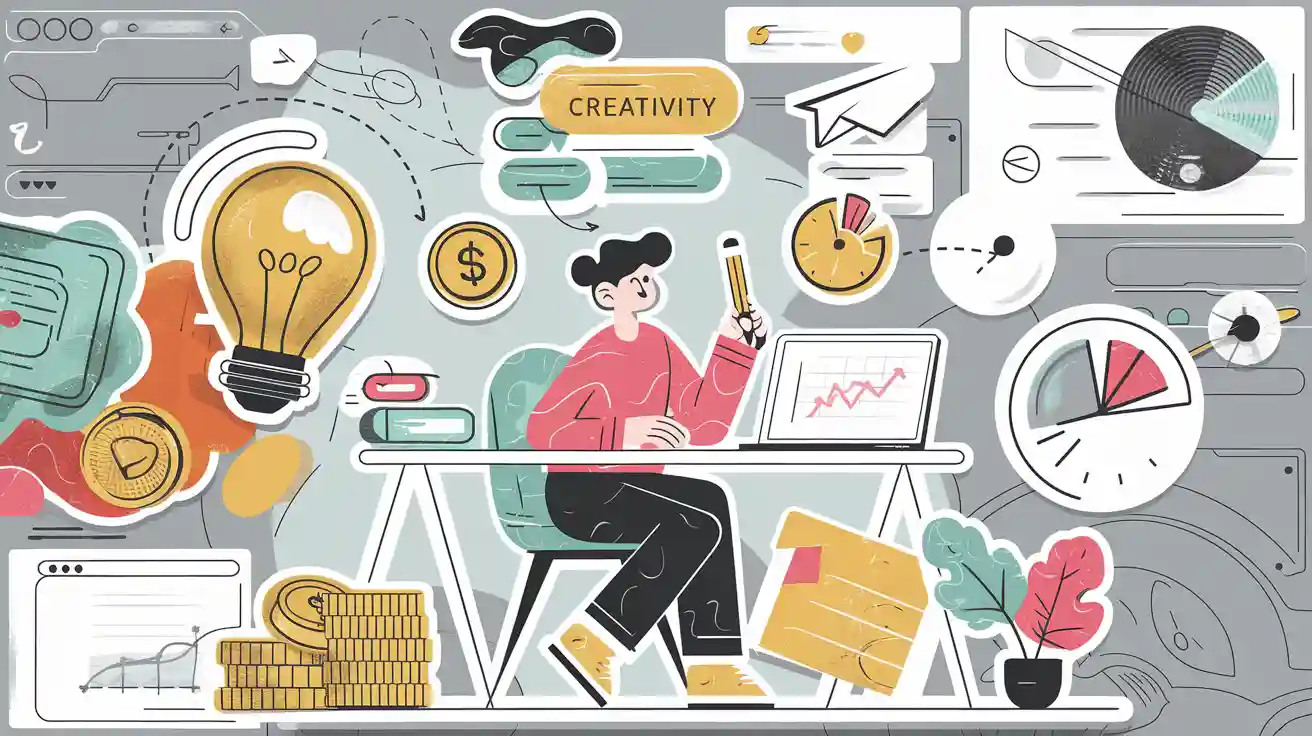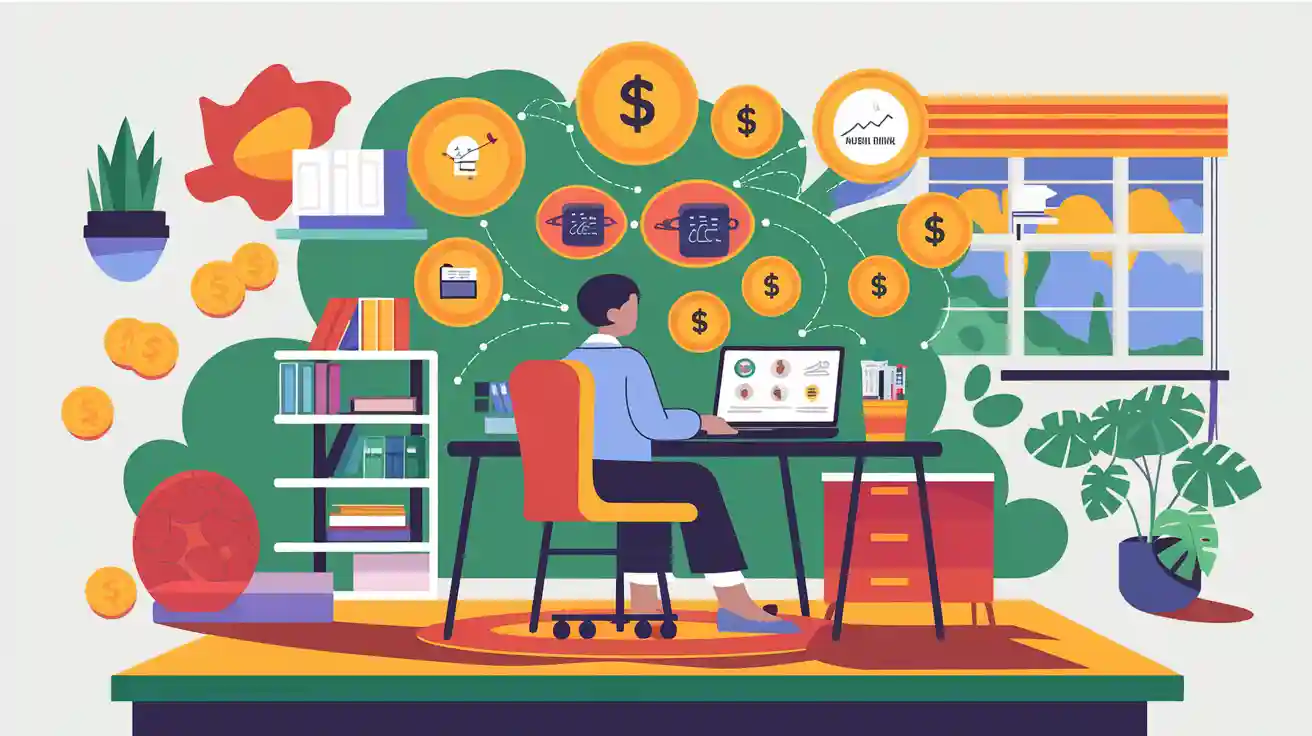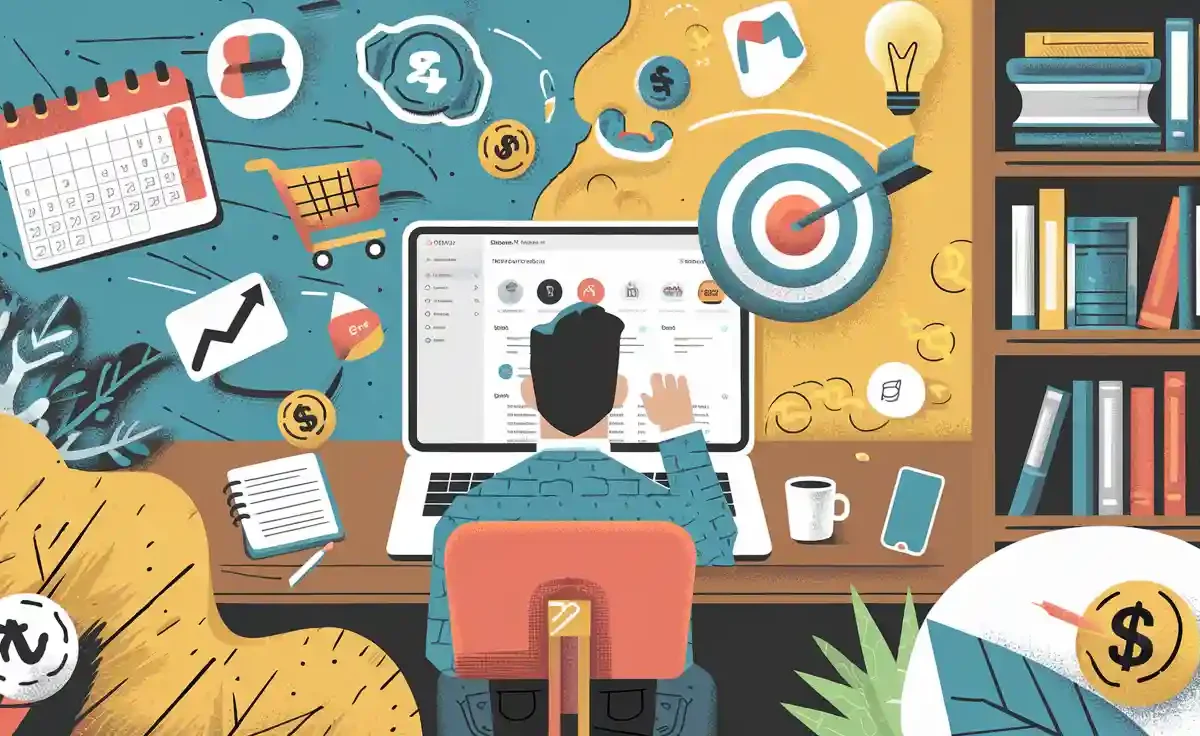
In 2025, passive side hustles are more than just a trend—they’re a lifeline for creative individuals like you. With 34% of Americans already juggling side gigs and 24% planning to start one this year, it’s clear that the world is embracing new ways to earn money. Why? Rising costs and job instability are pushing people to seek financial freedom and schedule flexibility. For creatives, this is the perfect time to turn your passion into profit.
The digital economy is booming, and platforms like Canva and AI tools make content creation easier than ever. Whether it’s blogging, video creation, or designing templates, you can build a sustainable income stream while doing what you love. Imagine earning money while you sleep—sounds like a dream, right? It’s time to start your side hustle and unlock your creative potential.
Key Takeaways
Try passive side jobs to make money from your creativity. The online world has many chances for creative people.
Selling digital art or printables can make good money. Use sites like Etsy to find buyers without making physical products.
Licensing music or sound effects is becoming popular. Make great audio and upload it to earn money over time.
Making online courses lets you teach what you know. Pick timeless topics to get students and earn money for years.
Writing e-books can bring steady income for a long time. Pick a specific topic and sell your book on sites like Amazon.
1. Selling Digital Art and Printables
Why It’s One of the Best Side Hustles
Selling digital art and printables is one of the best side hustles for creative people like you. Why? The market is booming! The online art market is expected to hit $6.81 billion in 2025 and grow to $10.55 billion by 2034, with a steady annual growth rate of 4.98%. This means more people are buying digital art than ever before.
What makes this hustle even better is its simplicity. You don’t need to worry about production costs or inventory. Once you create your art, you can sell it unlimited times without spending extra money. Plus, customers can download their purchases instantly, making the process seamless for both you and them.
How to Make Money with Digital Art
You can make money with digital art in several ways. Start by creating unique designs, illustrations, or templates that people love. Platforms like Etsy allow you to sell printables such as planners, calendars, or wall art. You can also offer custom illustrations or game assets, which are in high demand.
Here’s a quick look at potential earnings:
Sales Method | Estimated Earnings |
|---|---|
Selling digital prints on Etsy | $500–$5,000/month |
Selling custom illustrations | $50–$500 per commission |
Selling game assets | $100–$10,000+ per bundle |
The best part? You can scale your income by creating more designs or targeting niche markets.
Tools and Platforms for Selling Printables
To sell printables, you’ll need the right tools and platforms. Canva is a fantastic tool for designing professional-looking art, even if you’re not a graphic designer. For selling, platforms like Etsy, Gumroad, and Creative Market are popular choices.
Here’s why these platforms work so well:
No production costs: You can sell your designs repeatedly without extra expenses.
No inventory: Forget about managing stock or shipping.
Instant delivery: Customers get their downloads immediately, boosting satisfaction.
With these tools and platforms, you can turn your creative passion into a profitable side hustle.
Inspiring Success Stories
Looking for some inspiration? Let’s dive into a few success stories of creative minds who turned their passion for digital art into thriving side hustles.
Emily’s Etsy Empire
Emily, a stay-at-home mom, started selling printable planners on Etsy in 2023. She used Canva to design simple yet stylish templates. Within six months, her shop gained traction, earning her $2,000 a month. Emily credits her success to focusing on a niche—minimalist planners for busy moms. Her advice? “Start small, but stay consistent. Your audience will find you.”Jake’s Game Asset Goldmine
Jake, a freelance illustrator, decided to create game assets during his downtime. He uploaded bundles of character sprites and backgrounds to platforms like Gumroad. One of his bundles went viral among indie game developers, earning him over $15,000 in passive income in just one year. Jake says, “Don’t underestimate the power of targeting a specific market. Gamers are always looking for fresh designs.”Sophia’s Wall Art Success
Sophia, a graphic designer, turned her love for abstract art into a side hustle. She started selling digital wall art on Creative Market. Her unique, vibrant designs caught the attention of interior designers, leading to steady monthly earnings of $3,500. Sophia’s tip? “Focus on quality over quantity. A few standout pieces can make all the difference.”
Pro Tip: Take a page from their playbooks. Find your niche, create high-quality designs, and use platforms that align with your audience.
These stories prove that with creativity and persistence, you can achieve amazing results. What’s stopping you from becoming the next success story?
2. Licensing Music or Sound Effects
Why It’s a Creative Passive Side Hustle
If you’re musically inclined, licensing your music or sound effects is one of the best side hustles for creative people like you. The demand for licensed audio is skyrocketing, thanks to the explosion of content creation in 2025. Think about it—every YouTube video, podcast, or indie film needs background music or sound effects.
Here’s why this hustle works so well:
The independent artist market is projected to grow to $149.91 billion by 2029.
Sync music, used in ads, movies, and shows, reached $302.9 million in 2021 and continues to rise.
Indie musicians with 500 million streams increased by 2% in 2024 compared to 2023.
This side hustle doesn’t just generate passive income. It also helps you build your personal brand as an artist while your work gains exposure.
How to Make Money Licensing Music
You can make money by licensing your tracks for various projects. Start by creating high-quality music or sound effects that fit specific niches, like cinematic scores, lo-fi beats, or ambient sounds. Once you’ve got your portfolio, upload your work to licensing platforms.
Here’s where the magic happens:
Content creators pay for the rights to use your music in their projects.
You earn royalties every time your track is downloaded or streamed.
Over time, your portfolio grows, and so does your income.
Pro tip: Focus on evergreen genres like acoustic, electronic, or cinematic music. These are always in demand.
Tools and Platforms for Licensing
To get started, you’ll need the right platforms. Here are some of the most effective ones in 2025:
AudioJungle
Artlist
Pond5
Shutterstock’s PremiumBeat
Tracklib
These platforms connect you with content creators, filmmakers, and advertisers looking for unique audio. They handle licensing, so you can focus on creating.
Tip: Diversify your uploads across multiple platforms to maximize your reach and earnings.
Licensing music or sound effects is one of the most rewarding side hustle ideas for creative minds. It’s time to turn your talent into a steady stream of money.
Real-Life Examples of Success
Looking for proof that licensing music or sound effects can work for you? Let’s explore some real-life success stories that show how creatives have turned their passion for audio into a steady income stream.
Alex’s Lo-Fi Beats Journey
Alex, a part-time musician, started creating lo-fi beats in his bedroom. He uploaded his tracks to platforms like Artlist and Epidemic Sound. Within a year, his music was featured in hundreds of YouTube videos and podcasts. His monthly royalties now average $3,000. Alex says, “I focused on creating relaxing, evergreen tracks that people could use in any setting. Consistency was key.”Maya’s Sound Effects Empire
Maya, a sound designer, began uploading sound effects like footsteps, door creaks, and ambient noises to Pond5. Her niche? Horror-themed sounds. Indie filmmakers loved her work, and one of her sound packs even got featured in a popular short film. Today, Maya earns over $2,500 a month in passive income. Her advice? “Find a niche and stick to it. The more specific, the better.”Chris’s Cinematic Scores Success
Chris, a composer, decided to license his cinematic scores on AudioJungle. His dramatic, orchestral pieces caught the attention of ad agencies and small production companies. One of his tracks was used in a viral commercial, earning him $10,000 in a single month. Chris shares, “Don’t underestimate the power of storytelling in your music. It makes your work stand out.”
Pro Tip: Start small, but think big. Focus on quality and consistency, and your audience will grow over time.
These stories prove that with creativity and persistence, you can turn your musical talent into a thriving side hustle. What’s stopping you from starting today?
3. Creating and Selling Online Courses
Why It’s Ideal for Creative People
Creating and selling online courses is one of the most rewarding side hustle ideas for creative minds. Why? The online education market is booming. By 2025, it’s expected to hit $341.72 billion, with the U.S. alone generating over $87.51 billion in revenue. This growth means more people are turning to digital learning for skills and certifications.
If you’re passionate about teaching, this is your chance to share your expertise. Whether it’s graphic design, freelance writing, or even online tutoring, you can create a course that helps others while earning passive income. Plus, the scalability of online courses makes them a perfect fit for creative individuals looking to maximize their impact.
How to Make Money Teaching Online
To make money with online courses, start by identifying a topic you’re skilled in. Think about what people want to learn—whether it’s how to create a course, master video editing, or improve their content creation skills. Once you’ve chosen a niche, break it down into easy-to-follow lessons.
Here’s a simple roadmap:
Plan Your Course: Outline your lessons and decide on the format (video, text, or a mix).
Create Engaging Content: Use visuals, quizzes, and examples to keep learners interested.
Choose a Platform: Upload your course to platforms like Udemy or Teachable.
Market Your Course: Use social media, email lists, or partnerships to attract students.
The best part? Once your course is live, it can generate income for years with minimal updates.
Tools and Platforms for Course Creation
Technology has made it easier than ever to create and sell online courses. Here are some tools and trends shaping the industry in 2025:
Trend | Description |
|---|---|
Mobile Learning | Design mobile-friendly courses to cater to learners on the go. |
Corporate Partnerships | Offer job-specific training to companies investing in employee development. |
Lifelong Learning | Focus on short courses and certifications for continuous skill-building. |
Improved Access | Reach remote and underserved areas with advancements in technology. |
For platforms, consider these popular options:
Udemy: Great for reaching a large audience.
Teachable: Perfect for building your own brand.
Skillshare: Ideal for creative courses like design or video editing.
With the right tools and a bit of effort, you can turn your knowledge into a profitable passive side hustle.
Pro Tip: Focus on evergreen topics that stay relevant over time. This ensures your course continues to attract students and generate income.
Examples of Successful Creators
Looking for inspiration? Let’s explore how some creators turned their skills into thriving online courses. These stories prove that with the right approach, you can do it too.
Sarah’s Graphic Design Masterclass
Sarah, a freelance graphic designer, noticed that many beginners struggled with Adobe Illustrator. She created a beginner-friendly course on Udemy, breaking down complex tools into bite-sized lessons. Her approachable teaching style resonated with students, and her course now earns her $4,000 a month. Sarah says, “I focused on solving a specific problem. That’s what made my course stand out.”James’s Photography Bootcamp
James, a professional photographer, launched a course on Skillshare teaching smartphone photography. He targeted hobbyists who wanted to take better photos without expensive gear. His course gained traction quickly, earning him $2,500 monthly. His advice? “Keep it simple. People love practical tips they can use right away.”Emma’s Watercolor Painting Workshop
Emma, an artist, turned her passion for watercolor painting into a course on Teachable. She included step-by-step tutorials and downloadable templates. Her course attracted art enthusiasts and even schools looking for creative activities. Today, she earns $3,000 a month. Emma shares, “Don’t underestimate the power of community. Engage with your students, and they’ll keep coming back.”
Pro Tip: Focus on a niche you know well. Whether it’s art, tech, or lifestyle, your unique perspective can make your course a hit.
These creators started small but stayed consistent. Their success shows that with effort and creativity, you can turn your knowledge into a profitable side hustle. What’s stopping you from starting your own course today?
4. Writing and Selling E-books
Why It’s a Great Passive Side Hustle
Writing and selling e-books is one of the most rewarding side hustles for creative people like you. Why? The e-book market is booming. In 2022, it was valued at $19.95 billion and is expected to grow to $32.19 billion by 2032. This growth means more readers are turning to digital books for knowledge, entertainment, and inspiration.
E-books offer a unique advantage. Once you write and publish your book, it can generate passive income for years. You don’t need to worry about inventory or shipping. Plus, platforms like Amazon Kindle Direct Publishing make it easy to reach a global audience. Whether you’re passionate about fiction, self-help, or niche topics, there’s a market waiting for your ideas.
How to Make Money Writing E-books
Making money with e-books starts with choosing the right topic. Think about what you’re passionate about or what skills you can share. Non-fiction books, like how-to guides or self-improvement topics, are especially popular. Fiction also has a loyal audience if storytelling is your strength.
Here’s a quick roadmap to get started:
Plan Your Book: Outline your chapters and decide on your target audience.
Write Consistently: Set aside time daily to write. Even 500 words a day adds up quickly.
Edit and Format: Use tools like Grammarly or hire a professional editor to polish your work.
Publish and Promote: Upload your e-book to platforms like Amazon or Apple Books. Use social media and email lists to market it.
Authors who publish multiple books see the best results. A recent study shows that 66% of authors selling direct have published at least five books. Those with ten or more books earn an average of $1,045 per month—five times more than those with fewer books.
Tools and Platforms for Publishing
The right tools and platforms make ebook writing and publishing easier than ever. Here are some top options:
Amazon Kindle Direct Publishing (KDP): The most popular platform for self-publishing. It offers global reach and tools to track your sales.
Apple Books: Perfect for reaching Apple users. It’s user-friendly and offers great visibility.
Barnes & Noble Press: A solid choice for authors targeting the U.S. market.
These platforms handle the technical side, so you can focus on writing. They also make it easy to update your book or create print-on-demand versions.
Pro Tip: Start with one platform, then expand to others for maximum reach.
E-books are a fantastic way to turn your creativity into a steady income stream. With the right tools and a bit of effort, you can build a successful writing side hustle that pays off for years to come.
Success Stories from Writers
Looking for inspiration to kickstart your e-book journey? Let’s dive into some real-life success stories of writers who turned their creativity into a steady income stream. These examples show what’s possible when you combine passion with persistence.
Anna’s Self-Help Bestseller
Anna, a life coach, decided to write an e-book about overcoming procrastination. She published it on Amazon Kindle Direct Publishing (KDP) in 2024. Her book, packed with actionable tips, resonated with readers struggling to stay productive. Within six months, it became a bestseller in the self-help category, earning her $5,000 a month. Anna says, “I focused on solving a common problem. That’s what made my book stand out.”Mark’s Sci-Fi Adventure Series
Mark, a part-time writer, always dreamed of creating a sci-fi universe. He wrote a series of short e-books and published them on multiple platforms, including Apple Books and Barnes & Noble Press. His engaging storytelling and cliffhanger endings kept readers coming back for more. Today, Mark earns over $3,500 monthly. His advice? “Start small. A series of shorter books can build momentum faster than a single long one.”Lisa’s Niche Cookbook Success
Lisa, a food blogger, turned her collection of gluten-free recipes into an e-book. She targeted a niche audience—people with dietary restrictions—and promoted her book through her blog and social media. Her e-book gained traction quickly, earning her $2,000 a month. Lisa shares, “Find your niche and connect with your audience. They’ll support you if your content solves their needs.”
Pro Tip: Focus on a specific audience or problem. Whether it’s fiction or non-fiction, your unique perspective can make your e-book a hit.
These stories prove that writing e-books isn’t just a dream—it’s a real opportunity. What’s stopping you from becoming the next success story?
5. Designing and Selling Templates
Why It’s Perfect for Creative Minds
Designing and selling templates is a fantastic way to turn your creative skills into a steady income stream. Templates are everywhere—businesses use them for presentations, educators need them for lesson plans, and event planners rely on them for invitations. The demand for customizable templates is growing because they save time and cater to specific needs.
In 2025, this trend is only getting bigger. Canva templates, for example, appeal to a wide range of users, from small business owners to nonprofits. Designers are also incorporating semi-custom templates into their workflows, making this side hustle even more profitable. If you enjoy creating visually appealing designs, this is one of the best side hustles for creative people like you.
How to Make Money with Templates
Making money with templates is easier than you think. Start by identifying your target audience. Are you designing for bloggers, educators, or event planners? Once you know who you’re creating for, focus on crafting templates that solve their problems.
Here’s a simple roadmap:
Choose Your Niche: Pick a specific category, like social media graphics or wedding invitations.
Create High-Quality Designs: Use tools like Canva or Adobe Illustrator to make your templates visually appealing and easy to use.
Optimize Your Listings: Include high-quality previews and relevant keywords to attract buyers.
Promote Your Templates: Share them on social media or collaborate with influencers to reach your audience.
Templates are a passive side hustle because once you upload them, they can generate income for years. The more templates you create, the more money you can earn.
Tools and Platforms for Template Design
The right tools and platforms can make all the difference in your success. Canva is a popular choice because it’s user-friendly and attracts a broad audience. Other platforms like Creative Market and Etsy are great for selling templates to niche markets.
Here’s why these platforms work so well:
Canva: Perfect for beginners and professionals alike. Its interface makes designing easy, and its marketplace connects you with buyers.
Creative Market: Ideal for selling unique, high-quality templates to creative professionals.
Etsy: Great for reaching small business owners and event planners looking for personalized designs.
By choosing the right platform and optimizing your listings, you can turn your creative passion into a profitable side hustle.
Examples of Successful Designers
Looking for inspiration to kickstart your template design journey? Let’s explore some real-life examples of designers who turned their creativity into thriving businesses. These stories prove that with the right approach, you can do it too.
Rachel’s Social Media Template Success
Rachel, a freelance graphic designer, noticed small businesses struggling with social media branding. She created a set of Instagram templates using Canva and listed them on Etsy. Her clean, modern designs quickly gained popularity among entrepreneurs. Within a year, Rachel was earning $3,000 a month in passive income. Her advice? “Focus on solving a specific problem. Business owners love tools that save them time.”Tom’s Presentation Template Empire
Tom, a former corporate employee, started designing PowerPoint templates for professionals. He uploaded his work to Creative Market, targeting consultants and educators. His templates, known for their sleek and professional look, became a hit. Today, Tom earns over $4,500 monthly. He says, “Consistency is key. Keep adding new designs to stay relevant.”Sophia’s Wedding Invitation Niche
Sophia, a stay-at-home mom, turned her passion for event planning into a side hustle. She designed elegant wedding invitation templates and sold them on Etsy. Her unique, customizable designs attracted brides-to-be, earning her $2,500 a month. Sophia shares, “Find a niche you love. When you enjoy the process, success follows.”
Pro Tip: Start small and focus on quality. A few standout templates can make a big difference in your sales.
These designers started with simple ideas and grew their businesses through creativity and persistence. What’s stopping you from becoming the next success story? 🚀
6. Building a Stock Photography Portfolio

Why It’s One of the Best Side Hustles for Creatives
If you love photography, building a stock photography portfolio is a fantastic way to turn your passion into profit. In 2025, the demand for high-quality visuals is skyrocketing. Businesses, marketers, and content creators need fresh images for websites, ads, and social media. This creates a golden opportunity for you to earn passive income while doing something you enjoy.
What makes this side hustle even better is its flexibility. You can shoot photos in your free time, upload them to stock platforms, and let the sales roll in. Plus, focusing on trending topics like artificial intelligence or futuristic themes can make your portfolio stand out. These themes are gaining popularity, and buyers are actively searching for them.
How to Make Money with Stock Photography
Making money with stock photography is simpler than you might think. Start by capturing high-quality, versatile images that appeal to a broad audience. Think about everyday objects, nature, or lifestyle shots. Then, upload your photos to stock platforms where buyers can purchase licenses to use them.
Here’s how you can maximize your earnings:
Focus on Trends: Use tools like Google Trends to identify popular topics. AI-related visuals, for example, are in high demand.
Diversify Your Portfolio: Include a mix of subjects to attract different buyers.
Optimize Keywords: Add relevant tags to your photos so they appear in search results.
The global stock photo market, valued at $3,425.2 million, is growing steadily. North America alone accounts for over 40% of this revenue, with a projected growth rate of 3.7% from 2024 to 2031. This means your photos have a massive audience waiting to discover them.
Tools and Platforms for Selling Photos
To succeed in stock photography, you need the right tools and platforms. Here are some of the best options:
Shutterstock: A popular platform with a large customer base.
Adobe Stock: Great for photographers who already use Adobe tools.
Alamy: Offers higher payouts compared to other platforms.
iStock: Ideal for beginners looking to break into the market.
These platforms handle the sales process, so you can focus on creating. Upload your photos, set your prices, and let the platforms do the rest.
Pro Tip: Consistency is key. Upload new photos regularly to keep your portfolio fresh and attract more buyers.
Building a stock photography portfolio is one of the most rewarding ways to combine your creative skills with a steady income stream. Why not grab your camera and start today?
Inspiring Success Stories
Curious about how others have turned their photography passion into a thriving side hustle? Let’s dive into some real-life success stories that prove you can do it too.
Liam’s Nature Photography Niche
Liam, a part-time photographer, loved capturing landscapes and wildlife during his weekend hikes. He decided to upload his best shots to Shutterstock and Adobe Stock. His vibrant nature photos quickly gained attention from travel bloggers and eco-friendly brands. Within a year, Liam was earning $2,000 a month in passive income. His advice? “Focus on what you love to shoot. Your passion will shine through your work, and buyers will notice.”Sophia’s Everyday Moments Portfolio
Sophia, a stay-at-home parent, started snapping candid photos of everyday life—kids playing, cozy home setups, and family meals. She uploaded her images to iStock, targeting lifestyle bloggers and small businesses. Her relatable and authentic photos became a hit, earning her $1,500 monthly. Sophia says, “Don’t overthink it. Simple, real-life moments often sell better than staged shots.”Ethan’s Tech-Themed Success
Ethan, a tech enthusiast, noticed a growing demand for futuristic and AI-related visuals. He began creating sleek, high-tech images using his DSLR and editing software. His portfolio on Adobe Stock attracted tech startups and marketing agencies. One viral image earned him $5,000 in a single month. Ethan shares, “Stay ahead of trends. If you see a topic gaining traction, create content for it before the market gets crowded.”
Pro Tip: Start with what you know. Whether it’s nature, lifestyle, or tech, your unique perspective can make your portfolio stand out.
These stories show that with creativity and consistency, you can turn your photography into a reliable income stream. What’s stopping you from starting your own success story? 📸
7. Developing Passive Income Apps or Games
Why It’s a Creative Way to Make Money
Developing apps or games is an exciting way to combine your creativity with technology. In 2025, the app market is thriving, thanks to advancements in AI and app-building tools. You don’t need to be a coding expert to get started. AI app builders make it easier than ever to create engaging applications that can generate ongoing revenue.
Why is this such a great opportunity? For one, apps and games offer a unique way to earn passive income. Once you’ve built and launched your app, it can continue to bring in money through in-app ads, subscriptions, or download fees. Plus, having a steady revenue stream can act as a financial cushion during uncertain times.
The best part? If your app stands out, the income potential is huge. Unique and creative apps often attract more users, leading to greater earnings.
How to Make Money with Apps or Games
Making money with apps or games starts with a great idea. Think about what users need or enjoy. Maybe it’s a productivity tool, a fun game, or a niche app that solves a specific problem. Once you have your concept, focus on creating an app that’s easy to use and visually appealing.
Here’s how you can monetize your app:
In-App Ads: Earn money every time users interact with ads in your app.
Subscriptions: Offer premium features for a monthly fee.
Download Fees: Charge users a one-time fee to download your app.
Keep in mind that the app market is competitive. To succeed, your app needs to offer unique value. Regular updates and engaging features can help maintain user interest and boost your income over time.
Tools and Platforms for Development
You don’t need a degree in computer science to create an app. Tools like AI app builders simplify the process, allowing you to focus on your creative vision. Here are some platforms to help you get started:
Adalo: Perfect for building apps without coding.
Unity: Ideal for creating games with stunning graphics.
Thunkable: A beginner-friendly platform for app development.
These tools handle the technical side, so you can focus on designing an app that stands out. With minimal initial investment, you can turn your idea into a profitable app or game.
Pro Tip: Start small. Test your app with a small audience, gather feedback, and improve it before scaling up.
Examples of Successful Developers
Looking for inspiration to kickstart your app or game development journey? Let’s explore some real-life examples of developers who turned their ideas into thriving passive income streams. These stories prove that with creativity and persistence, you can do it too.
Emma’s Mindfulness App
Emma, a yoga instructor, wanted to help people manage stress. She created a simple mindfulness app using Adalo. The app offered guided meditations and daily affirmations. Emma monetized it with a subscription model, charging $4.99 per month. Within a year, her app had over 10,000 subscribers, earning her $50,000 monthly. Emma says, “I focused on solving a problem I cared about. That made the process enjoyable and rewarding.”Jake’s Puzzle Game Success
Jake, a graphic designer, always loved puzzles. He used Unity to create a visually stunning puzzle game. The game featured unique levels and in-app purchases for hints. Jake marketed it on social media, and within six months, it had over 500,000 downloads. His monthly earnings from ads and purchases now exceed $8,000. Jake shares, “Start with a simple idea. You don’t need a big budget to create something people love.”Sophia’s Language Learning Tool
Sophia, a language enthusiast, built a language learning app using Thunkable. Her app focused on teaching niche languages like Icelandic and Swahili. She offered a free version with ads and a premium version for $9.99. Her unique approach attracted language learners worldwide, earning her $6,000 monthly. Sophia advises, “Find your niche. The more specific your app, the easier it is to stand out.”
Pro Tip: Start small and focus on solving a specific problem. Your unique perspective can make your app or game a hit.
These developers started with simple ideas and grew their projects into successful ventures. What’s stopping you from becoming the next success story? 🚀
Ready to start your journey? Begin by identifying your creative strengths. Whether it’s designing, writing, or photography, your unique skills can open doors to exciting opportunities. The digital economy is booming, offering scalable income streams with minimal upfront costs. Platforms like Canva, Etsy, and Shutterstock make it easier than ever to turn your passion into profit.
Consistency is your secret weapon. Develop a small, actionable plan and stick to it. Regular effort builds momentum and helps you adapt to challenges. Leverage technology to automate tasks and minimize ongoing effort. This approach not only saves time but also maximizes your earnings.
The future is bright for creative minds in 2025. Align your passions with market needs, and you’ll unlock both fulfillment and financial freedom. Why wait? Take the first step today and turn your creativity into a steady stream of money.
FAQ
What is a passive side hustle?
A passive side hustle is a way to earn money with minimal ongoing effort. You set it up once, like selling templates or licensing music, and it generates income over time. It’s perfect for creatives who want flexibility and financial freedom.
Do I need special skills to start?
Not necessarily! Many side hustles, like selling printables or stock photos, use tools like Canva or Shutterstock that simplify the process. Start with what you already know or enjoy, and learn as you go. Creativity and consistency matter more than expertise.
How much time does it take to set up?
It depends on the hustle. For example:
Selling templates: A few hours per design.
Writing e-books: Weeks or months.
Start small and dedicate consistent time weekly. Once set up, most require minimal maintenance.
Can I do this while working full-time?
Absolutely! Passive side hustles are flexible. You can work on them during weekends or evenings. Many successful creators started while juggling full-time jobs. The key is to stay consistent and focus on one project at a time.
How do I choose the right side hustle?
Ask yourself:
What are you passionate about?
What skills do you already have?
What’s in demand?
Start with something you enjoy and can commit to. Research trends and platforms to find the best fit for your creativity.
Tip: Don’t overthink it. Start small, experiment, and adjust as you learn.






